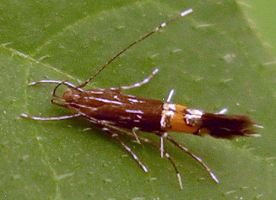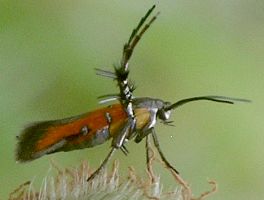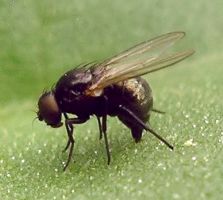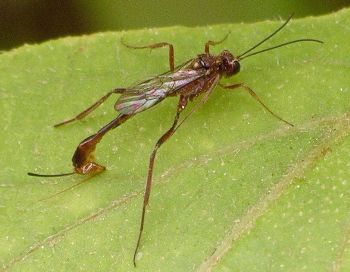
leaf mines: linear-blotch, serpentine, and digitate
The cells in the outer layers of leaves are a protective skin (the epidermis), and their main function is to provide a moisture-retaining cover, while allowing good stuff (sunlight and carbon dioxide) to come in and bad stuff (oxygen) to go out. These "skin" layers, on the top and bottom of each leaf, are usually rather tough and contain a lot of cellulose. The soft filling (the mesophyll), consisting of the cells that perform photosynthesis, is much more edible. When large mammals such as we humans eat leaves, we are not very discriminating and simply stuff the entire spinach, lettuce, or cabbage frond into our mouths, chew it up and swallow. We have plenty of space within our digestive system to accommodate both the cells that are nutritious and those that are useless fiber.

But not all animals are as big as we are, and those that are really miniscule live on an entirely different scale. To them, the few cells between the upper and lower surfaces of a leaf are like a deep-dish pizza, thick and juicy, just waiting to be devoured. To make this bonanza even more appealing, it is protected by a roof and floor that keep conditions inside as pleasant as central heat and air-conditioning do in our buildings.
It is not hard to find leaf mines, which are the visible signs of insects that have tunneled through the foliage as they eat their way to adulthood. Many kinds of plants bear these scars where the inner tissue has been destroyed. They are rarely of consequence to a plant's health, as the cells around the eaten ones can still perform their job of making food for the plant, and the leaf miners are not often very numerous.
 a particularly attractive linear leaf mine |
So what kinds of insects are leaf miners? Members of several different groups have adopted this lifestyle. They include tiny moths, flies, beetles and sawflies. It is always the larval stage that does the leaf mining. Depending on size and habit, the larva may even pupate at the end of its tunnel, or it may exit to do this in the soil or rolled in the edge of the leaf. By the way, leaf miners do not have common names, because the actual insects, being very tiny, are rarely seen. Studying these little critters takes a lot of patience and a microscope.
There are different styles of mines, and the shapes, along with identifying the plant, are the main means by which different kinds of leaf miners are recognized. Mines can be linear (also called serpentine) or blotch, and the names are pretty self-explanatory. Sometimes a linear mine turns into a blotch as the larva nears maturity. The linear mines start small and then gradually enlarge as the insect grows. They might zigzag or twist or follow the veins of the leaf and may have a dark stripe down the middle, which is composed entirely of excrement (what goes in must come out) and discretely referred to as a "frass line." If the mines gradually enlarge, they are called trumpet mines, but if they suddenly change from narrow to wide, they are called linear-blotch mines. Blotch mines are not nearly so artistic and usually just look like a blob. One kind, though, is sort of cool looking: digitate mines have finger-like lobes.
The adult insects that emerge are, as you might have already guessed, very small. They are not invisible, though, and some are downright gorgeous. It just takes a sharp eye, and the knowledge of what one is looking at, to appreciate them. While many of the leaf miner flies are rather plain, some of the moths are little jewels. Metallic scales, bright colors, and odd postures characterize several families of leaf-mining moths. One of my favorites is Heliodinidae, a family that includes orange and silver moths measuring about 5 mm in length. Some of the adult moths hold their legs in odd positions so they don't look particularly moth-like.
 Cosmopterix sp., a moth |  Aetole sp., a moth |  an agromyzid fly ovipositing |
Because of the protective layers of cells on both top and bottom, it is easy to assume that leaf miners have no predators. But they do. Some insects deposit their eggs on the leaf surface, and these are then vulnerable to scavengers and wandering predators until the grub, maggot, or caterpillar hatches and burrows down into the leaf. Ladybird beetles and their larvae, lacewing larvae, and velvet mites are examples of minute wandering predators that love to eat insect eggs. Once a larva is ensconced within the leaf and is munching away, it is still subject to predators that can break through the epidermis. We humans are not the only creatures capable of noticing the telltale signs on the plant! In fact, some predators and
 Ichneumon ovipositing into hidden leaf miner |
Ichneumons are parasitoid relatives of wasps and usually lay their eggs inside an unfortunate host insect. They often have long ovipositors sticking out their rear end and sometimes it looks like ichneumons are laying their eggs into flowers or tree trunks. They are actually ovipositing on larval insects that happen to be feeding in those locations. There is one tiny ichneumon that I frequently see in this area, usually around garden flowers, and the species is so small that I cannot tell much about them until I look at the resulting photographs. One specimen seemed to be injured or dead and did not move while I took a few pictures. While I was glad to have a cooperative subject for a change, I didn't expect the images to be very satisfactory, as dead insects usually look, well, dead. However, this time I was surprised to see that the tiny beast had its ovipositor stuck down into a leaf and was obviously depositing an egg into some unseen insect contained therein. It was as if the two-dimensional world of Flatland was being invaded by a monster from Spaceland!
Although not hard to see, leaf mines created by insects are easy to overlook. However, a short search of almost any garden, forest edge, or weed patch will turn up at least a few. Their myriad shapes and sizes are like miniature works of art, carved into living plants by mindless little animals as they go about the most mundane activities of existence.